Recognition and Analysis of an Age-Friendly Intelligent Sofa Design Based on Skeletal Key-Points
Abstract
:1. Introduction
1.1. Contributions
- We broke through the limitations of traditional two-dimensional anthropometric measurements and the concept of human behavior threshold is introduced; the three-dimensional data generated by human behavior were organically combined to break the shackles of space and extend the flat research to a three-dimensional space.
- After data collection and sampling, it was clear that the high-frequency use of furniture in the elderly group revolved around the sofa; the concentration obstacle was in the process of completing the sitting-to-stand transition. With the help of the Kinect device, the user’s behavior was collected and the code was compiled independently to convert the image into the three-dimensional coordinates of the key points of the human skeleton, and further map to 12 key joint angles. Afterward, the joint angles were effectively clustered; the central behavioral postures of the elderly group to complete the sit-to-stand transformation posture and the most important angle that affected the posture transformation were the trunk-arm angles 5-2.
- Based on the behavioral comfort model of elderly users to guide the general design, the intelligent age-friendly sofa was integrated into the assisted standing-up function to help users realize the conversion of sitting and standing postures.
1.2. Paper Outline
1.3. Notations
2. Intelligent Age-Friendly Seating Pain Point Analysis
3. Methodology
3.1. Participants
3.2. Apparatus
3.3. Experimental Design
3.4. Pre-Experiment Preparation
4. Results
Static Posture
5. Construction of a Behavioral Comfort Model for Elderly Users
6. Application and Validation
6.1. Product Design
6.2. Product Verification
6.3. EMG Signal Acquisition Analysis
6.4. Comparison of the Methods and Discussion
7. Conclusions
Author Contributions
Funding
Institutional Review Board Statement
Informed Consent Statement
Data Availability Statement
Acknowledgments
Conflicts of Interest
Abbreviations
| AHP | analytic hierarchy process |
| SPSS | Statistical Product Service Solutions |
References
- Chen, Y.; Bouferguene, A.; Shen, Y.; Al-Hussein, M. Difference analysis of regional population ageing from temporal and spatial perspectives: A case study in China. Reg. Stud. 2019, 53, 849–860. [Google Scholar] [CrossRef]
- Hansen, R.J.; Talmage, C.A.; Thaxton, S.P.; Knopf, R.C. Barriers to Age-Friendly Universities (AFU): Lessons from Osher Lifelong Learning Institute demographics and perceptions. Gerontol. Geriatr. Educ. 2019, 40, 221–243. [Google Scholar] [CrossRef] [PubMed]
- Cheng, Y.; Gao, S.; Li, S.; Zhang, Y.; Rosenberg, M. Understanding the spatial disparities and vulnerability of population aging in China. Asia Pac. Policy Stud. 2019, 6, 73–89. [Google Scholar] [CrossRef]
- Ogura, S.; Jakovljevic, M.M. Editorial: Global Population Aging - Health Care, Social and Economic Consequences. Front. Public Health 2018, 6, 335. [Google Scholar] [CrossRef]
- Hayslip, B., Jr.; Fruhauf, C.A.; Dolbin-MacNab, M.L. Grandparents Raising Grandchildren: What Have We Learned Over the Past Decade? Gerontologist 2017, 59, e152–e163. [Google Scholar] [CrossRef]
- Pedell, S.; Borda, A.; Keirnan, A.; Aimers, N. Combining the Digital, Social and Physical Layer to Create Age-Friendly Cities and Communities. Int. J. Environ. Res. Public Health 2021, 18, 325. [Google Scholar] [CrossRef] [PubMed]
- Wang, S. Spatial patterns and social-economic influential factors of population aging: A global assessment from 1990 to 2010. Soc. Sci. Med. 2020, 253, 112963. [Google Scholar] [CrossRef]
- Li, D.; Wu, S. Effects of An Aging Population in Shaanxi Province on Consumption Structure. In Proceedings of the International Conference on Transformations and Innovations in Management (ICTIM 2017), Shanghai, China, 9–10 September 2017; Atlantis Press: Paris, France, 2017; pp. 300–311. [Google Scholar] [CrossRef]
- Khan, S.F. Health care monitoring system in Internet of Things (IoT) by using RFID. In Proceedings of the 2017 6th International Conference on Industrial Technology and Management (ICITM), Cambridge, UK, 7–10 March 2017; pp. 198–204. [Google Scholar] [CrossRef]
- Khaksar, S.M.S.; Khosla, R.; Chu, M.T. Socially assistive robots in service innovation context to improve aged-care quality: A grounded theory approach. In Proceedings of the 2015 IEEE 7th International Conference on Cybernetics and Intelligent Systems (CIS) and IEEE Conference on Robotics, Automation and Mechatronics (RAM), Siem Reap, Cambodia, 15–17 July 2015; pp. 161–166. [Google Scholar] [CrossRef]
- Yang, Z.; Zhang, L.; Wu, Z. Research on performance evaluation of urban furniture function design based on internet of things digitization. IEEE Access 2022, 10, 72895–72906. [Google Scholar] [CrossRef]
- Wang, N.; Mao, B. The Research on the Problems of Smart Old-Age Care in the Background of Smart City Construction. In Proceedings of the 2019 International Conference on Intelligent Transportation, Big Data Smart City (ICITBS), Changsha, China, 12–13 January 2019; pp. 151–154. [Google Scholar] [CrossRef]
- Doulah, A.; Shen, X.; Sazonov, E. Early Detection of the Initiation of Sit-to-Stand Posture Transitions Using Orthosis-Mounted Sensors. Sensors 2017, 17, 2712. [Google Scholar] [CrossRef]
- Wei, T.; Zhu, Q.; Glomsrd, S. Ageing Impact on the Economy and Emissions in China: A Global Computable General Equilibrium Analysis. Energies 2018, 11, 817. [Google Scholar] [CrossRef]
- Mutombo, P.; Torres, A.; Kapralos, B.; Gamble, B.; Adams, C.; Lawson, L.; Da Silva, C.; Dubrowski, A. An Innovative Virtual Learning Environment to Enhance Age-Friendly Cultural Competencies. In Proceedings of the 2021 IEEE 45th Annual Computers, Software, and Applications Conference (COMPSAC), Madrid, Spain, 12–16 July 2021; pp. 1381–1382. [Google Scholar] [CrossRef]
- Bao, J.; Tang, Q.; Chen, Y. The spatiality and driving forces of population ageing in China. Biosci. Trends 2017, 11, 694–696. [Google Scholar] [CrossRef] [PubMed]
- Qureshi, M.H.; Masood, Z.; Rehman, L.; Owais, M.; Khan, M.U. Biomechanical Design and Control of Lower Limb Exoskeleton for Sit-to-Stand and Stand-to-Sit Movements. In Proceedings of the 2018 14th IEEE/ASME International Conference on Mechatronic and Embedded Systems and Applications (MESA), Oulu, Finland, 2–4 July 2018; pp. 1–6. [Google Scholar] [CrossRef]
- Xiong, X.; Ma, Q.; Yuan, Y.; Wu, Z.; Zhang, M. Current situation and key manufacturing considerations of green furniture in China: A review. J. Clean. Prod. 2020, 267, 121957. [Google Scholar] [CrossRef]
- Rocha-Ibarra, E.; Oros-Flores, M.I.; Almanza-Ojeda, D.L.; Lugo-Bustillo, G.A.; Rosales-Castellanos, A.; Ibarra-Manzano, M.A.; Gomez, J.C. Kinect Validation of Ergonomics in Human Pick and Place Activities Through Lateral Automatic Posture Detection. IEEE Access 2021, 9, 109067–109079. [Google Scholar] [CrossRef]
- Xiong, X.; Guo, W.; Fang, L.; Zhang, M.; Lu, R.; Miyakoshi, T. Current state and development trend of Chinese furniture industry. J. Wood Sci. 2017, 63, 433–444. [Google Scholar] [CrossRef]
- Lu, H.; Li, D. The development of a smart chair to assist sit-to-stand transferring process. In Proceedings of the 2014 UKACC International Conference on Control (CONTROL), Loughborough, UK, 9–11 July 2014; pp. 714–719. [Google Scholar] [CrossRef]
- Li, X.; Shen, L.; Califano, R. The comparative study of thermal comfort and sleep quality for innovative designed mattress in hot weather. Sci. Technol. Built Environ. 2020, 26, 643–657. [Google Scholar] [CrossRef]
- Chorin, F.; Beaune, B.; Frere, J.; Rahmani, A. Sit to stand in elderly fallers vs non-fallers: New insights from force platform and electromyography data. Aging Clin. Exp. Res. 2016, 28, 871–879. [Google Scholar] [CrossRef]
- Xu, Z.; Yu, N.; Hu, H.; Bai, Y.; Hong, P. Study on the Handle Test Sample of Furniture for Ergonomics Experiment. In Advances in Usability, User Experience and Assistive Technology; Ahram, T.Z., Falcao, C., Eds.; Springer: Cham, Switzerland, 2019; pp. 504–515. [Google Scholar]
- Martinez, M.; Stiefelhagen, R. Kinect unbiased. In Proceedings of the 2014 IEEE International Conference on Image Processing (ICIP), Paris, France, 27–30 October 2014; pp. 5791–5795. [Google Scholar] [CrossRef]
- DiFilippo, N.M.; Jouaneh, M.K. Characterization of Different Microsoft Kinect Sensor Models. IEEE Sens. J. 2015, 15, 4554–4564. [Google Scholar] [CrossRef]
- Kim, C.; Yun, S.; Jung, S.W.; Won, C.S. Color and Depth Image Correspondence for Kinect v2. In Advanced Multimedia and Ubiquitous Engineering; Park, J.J.J.H., Chao, H.C., Arabnia, H., Yen, N.Y., Eds.; Springer: Berlin/Heidelberg, Germany, 2015; pp. 111–116. [Google Scholar]
- Adams, R.J.; Lichter, M.D.; Krepkovich, E.T.; Ellington, A.; White, M.; Diamond, P.T. Assessing Upper Extremity Motor Function in Practice of Virtual Activities of Daily Living. IEEE Trans. Neural Syst. Rehabil. Eng. 2015, 23, 287–296. [Google Scholar] [CrossRef]
- Fu, J.; Miao, D.; Yu, W.; Wang, S.; Lu, Y.; Li, S. Kinect-Like Depth Data Compression. IEEE Trans. Multimed. 2013, 15, 1340–1352. [Google Scholar] [CrossRef]
- Tolgyessy, M.; Dekan, M.; Chovanec, L. Skeleton Tracking Accuracy and Precision Evaluation of Kinect V1, Kinect V2, and the Azure Kinect. Appl. Sci. 2021, 11, 5756. [Google Scholar] [CrossRef]
- Taifa, I.W.R. A student-centred design approach for reducing musculoskeletal disorders in India through Six Sigma methodology with ergonomics concatenation. Saf. Sci. 2022, 147, 105579. [Google Scholar] [CrossRef]
- Li, H.; Wen, K.H. Research on Design of Stalk Furniture Based on the Concept and Application of Miryoku Engineering Theory. Sustainability 2021, 13, 13652. [Google Scholar] [CrossRef]
- Prieto-Lage, I.; Ayan, C.; Alonso-Fernandez, D.; Parames-Gonzalez, A.; Argibay-Gonzalez, J.C.; Taboada-Solla, E.; Gutierrez-Santiago, A. Degree of mismatch between anthropometric characteristics and school furniture in a sample of Spanish students aged 6–12 years old: A pilot study. Arch. Argent. Pediatr 2021, 119, 386–393. [Google Scholar] [PubMed]
- Mao, A.; Zhang, H.; Xie, Z.; Yu, M.; Liu, Y.J.; He, Y. Automatic Sitting Pose Generation for Ergonomic Ratings of Chairs. IEEE Trans. Vis. Comput. Graph. 2021, 27, 1890–1903. [Google Scholar] [CrossRef] [PubMed]
- Castellucci, H.I.; Viviani, C.; Arezes, P.; Molenbroek, J.F.; Martinez, M.; Aparici, V. Application of mismatch equations in dynamic seating designs. Appl. Ergon. 2021, 90, 103273. [Google Scholar] [CrossRef] [PubMed]

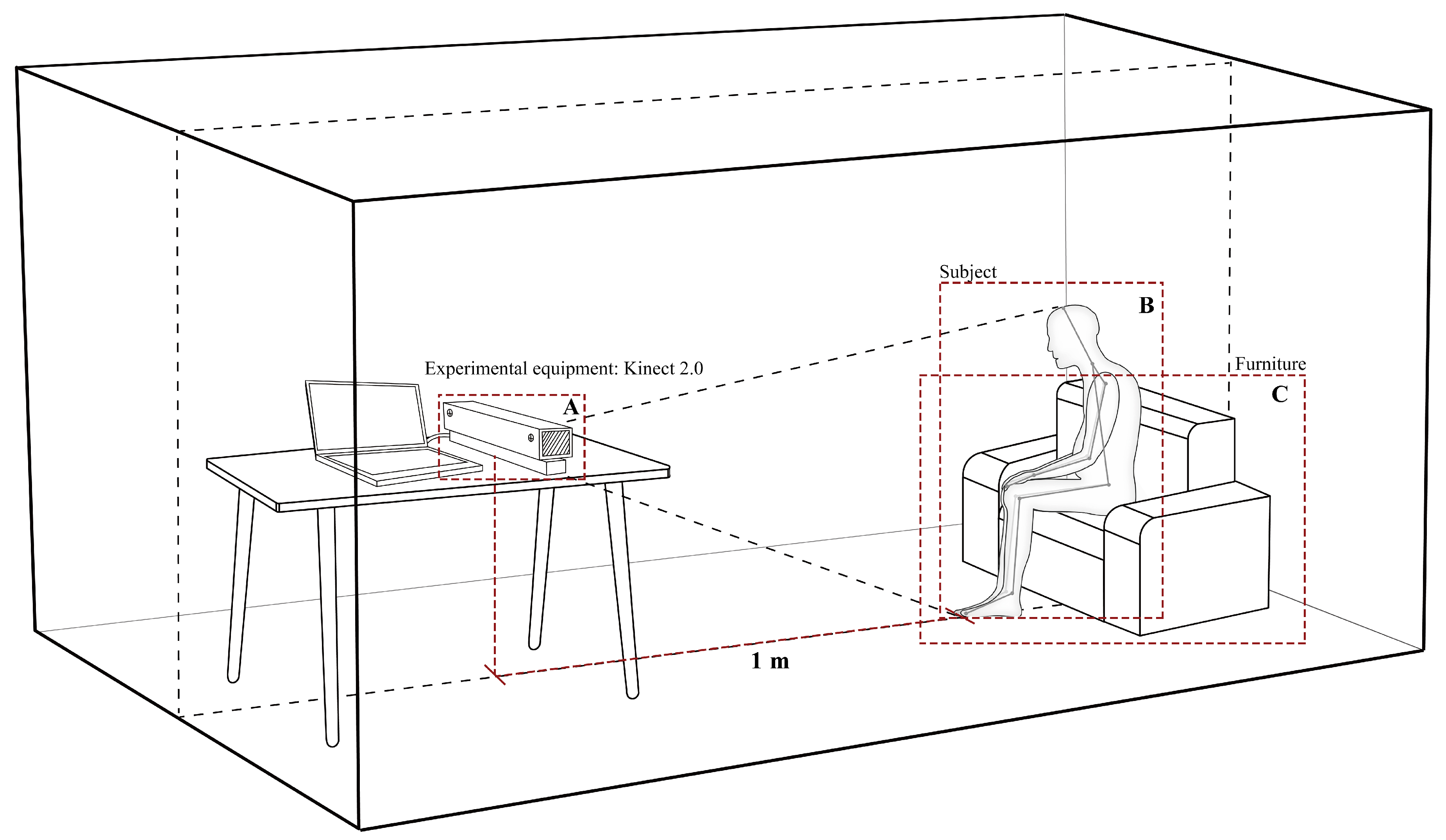
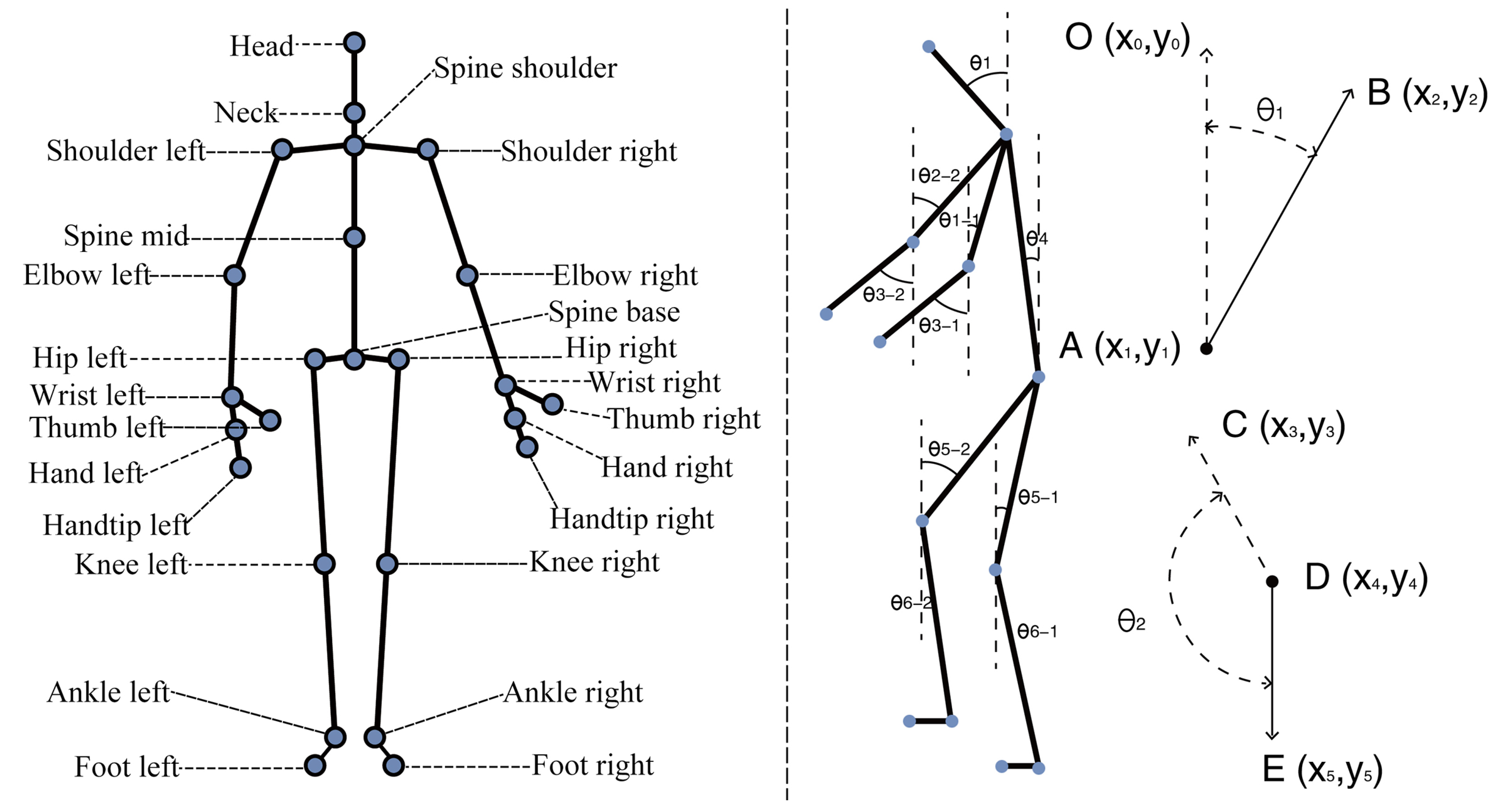
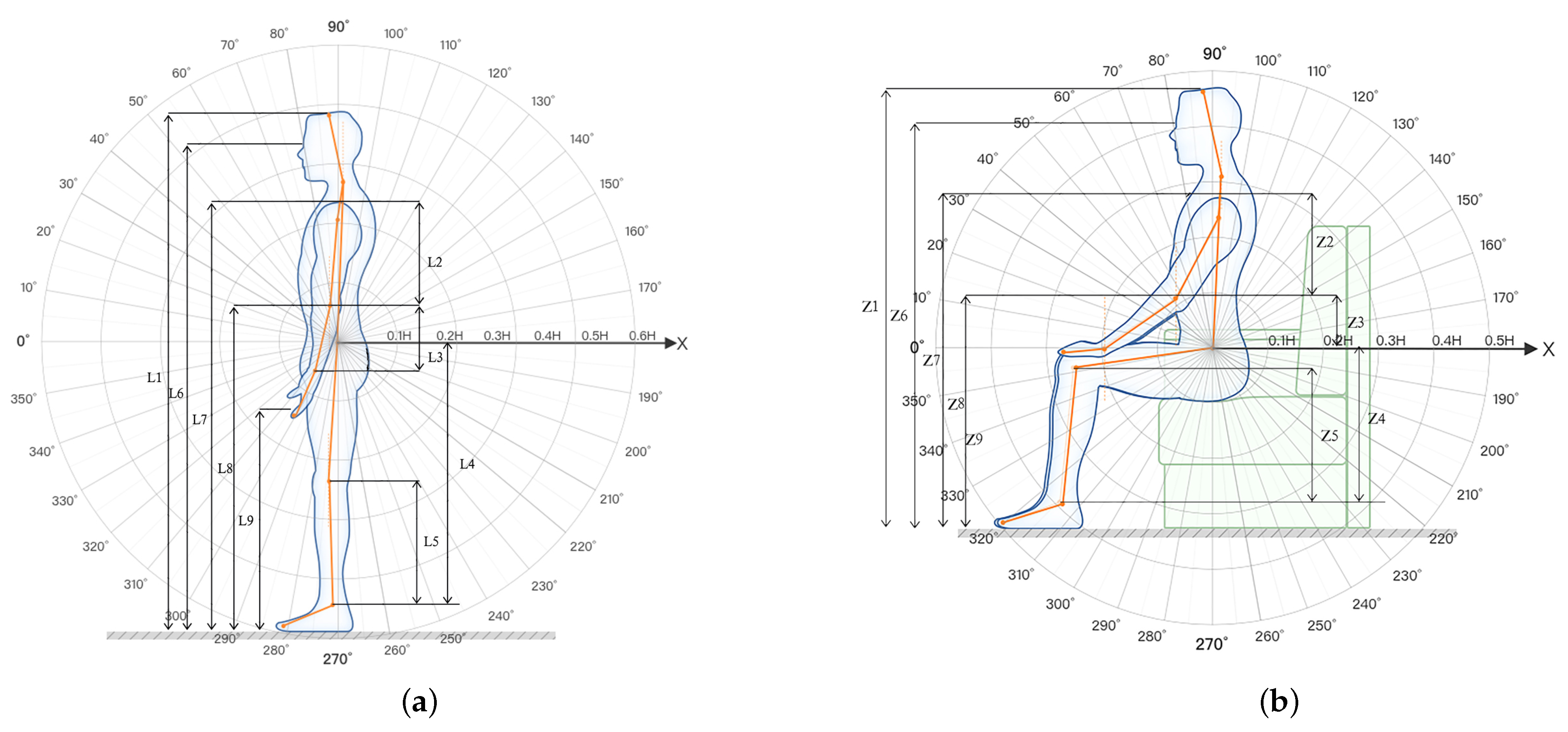

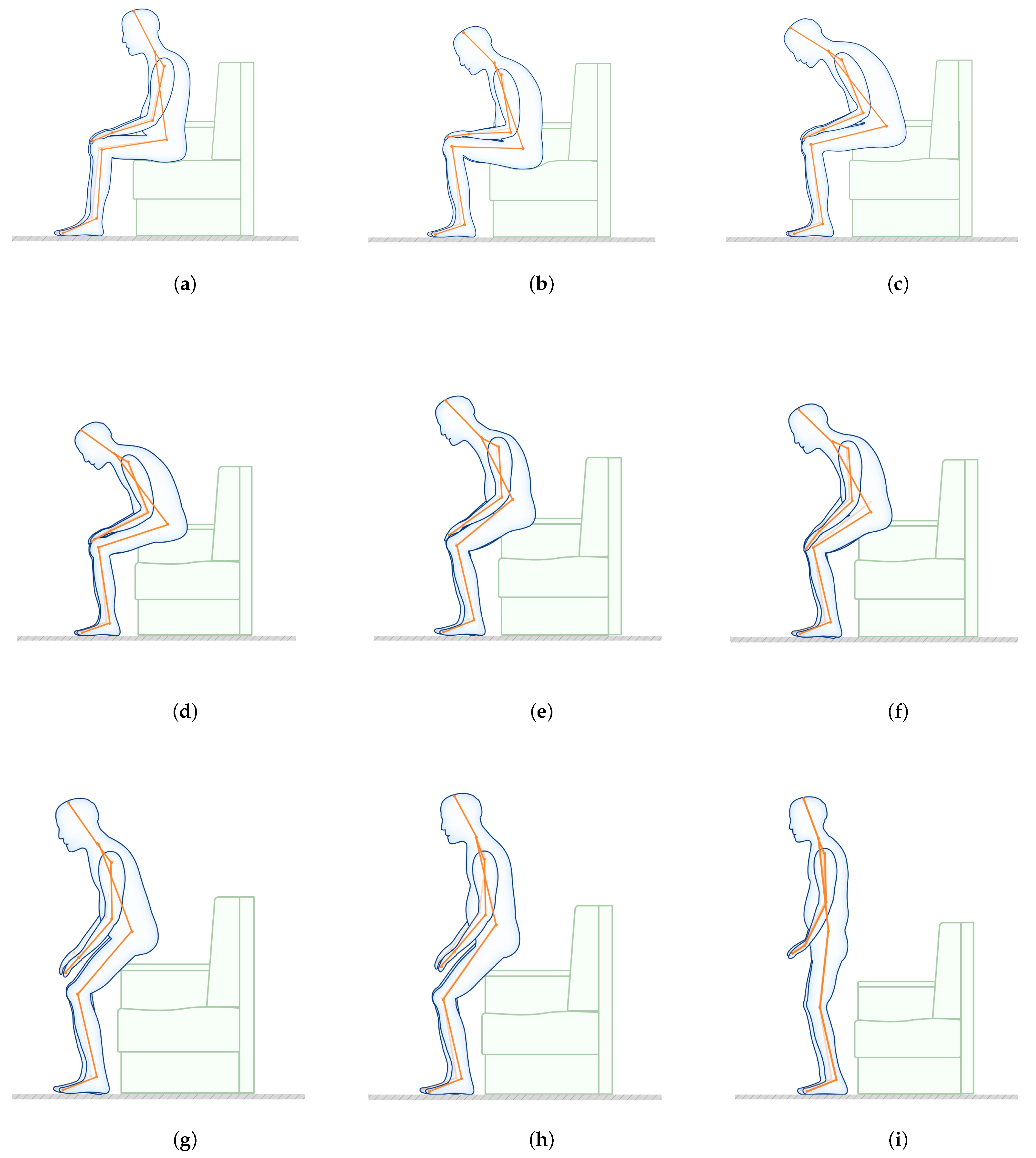
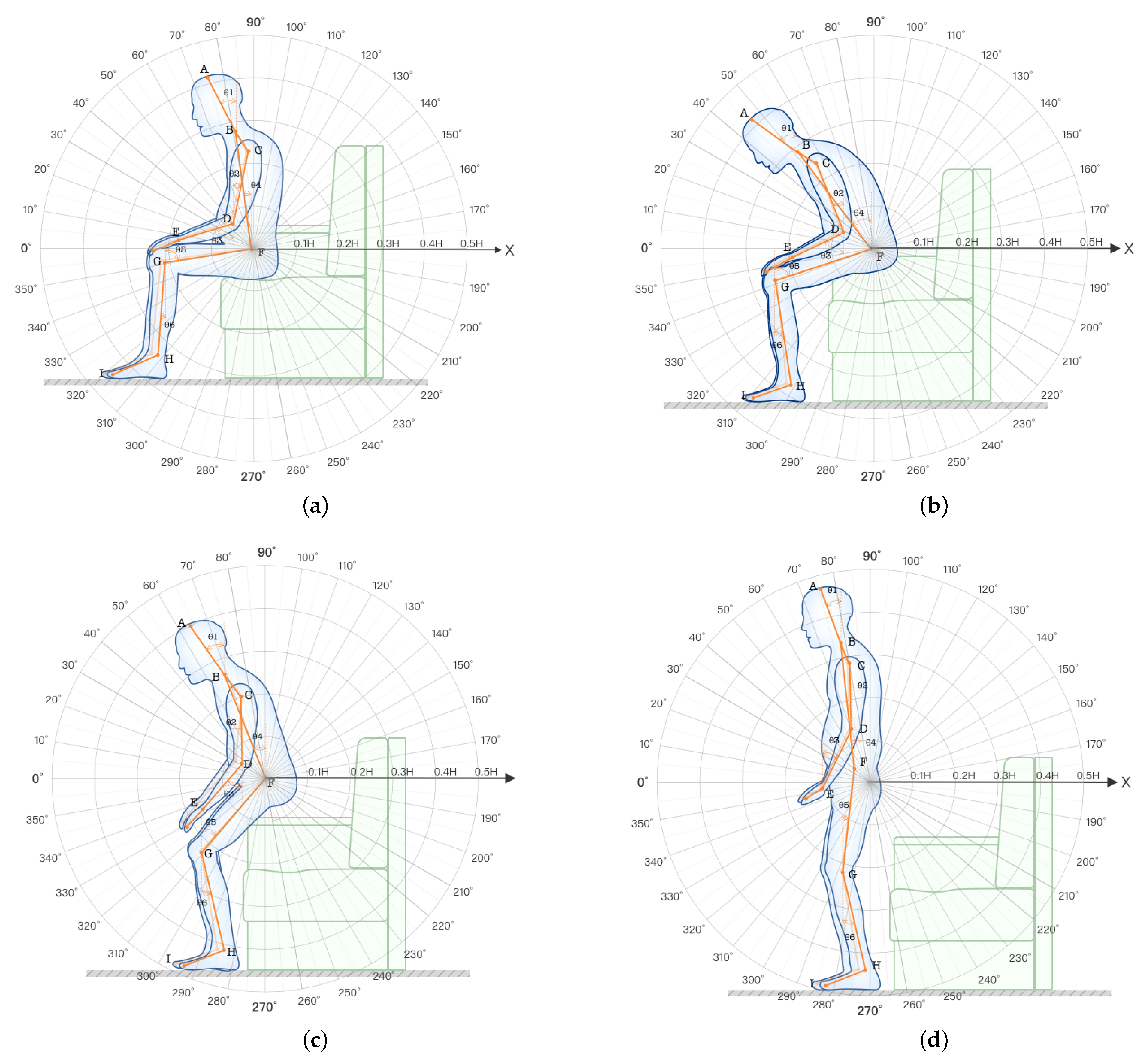
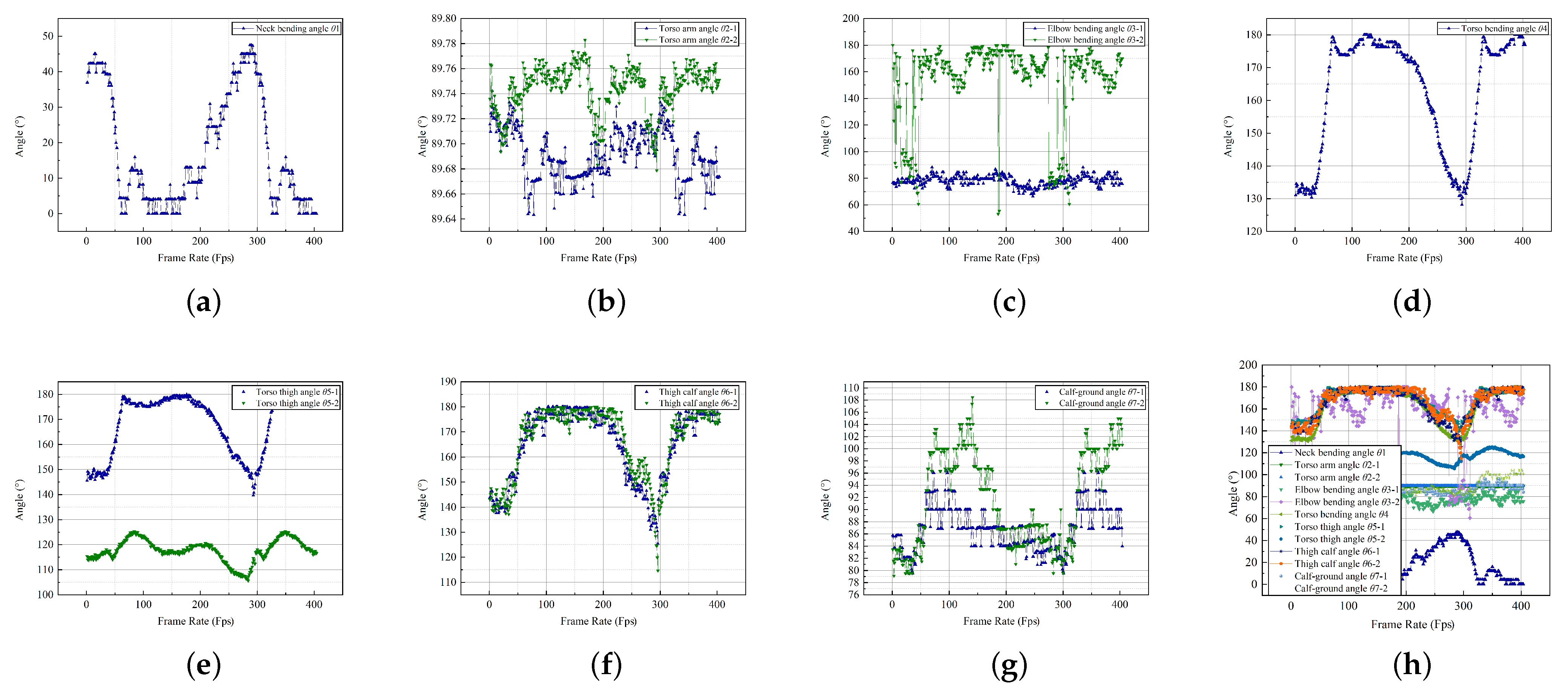
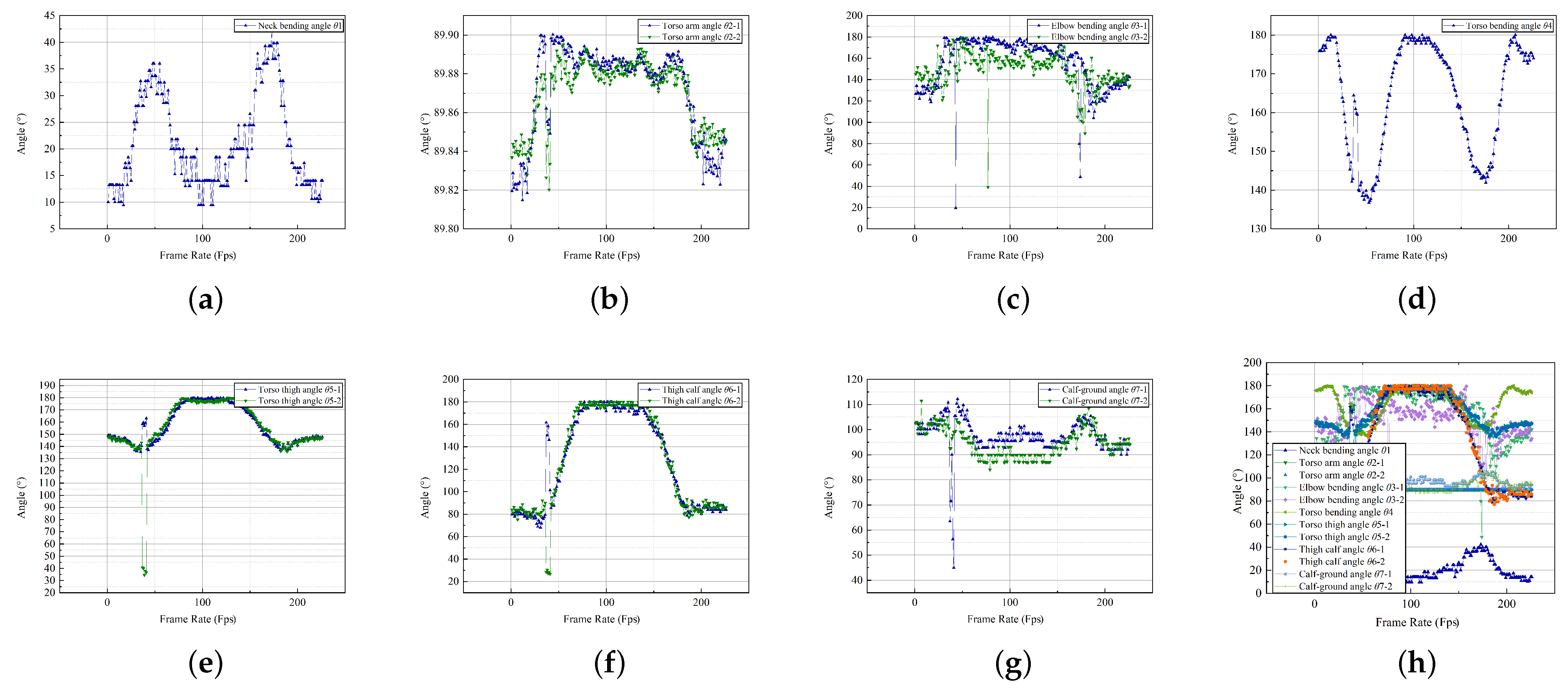


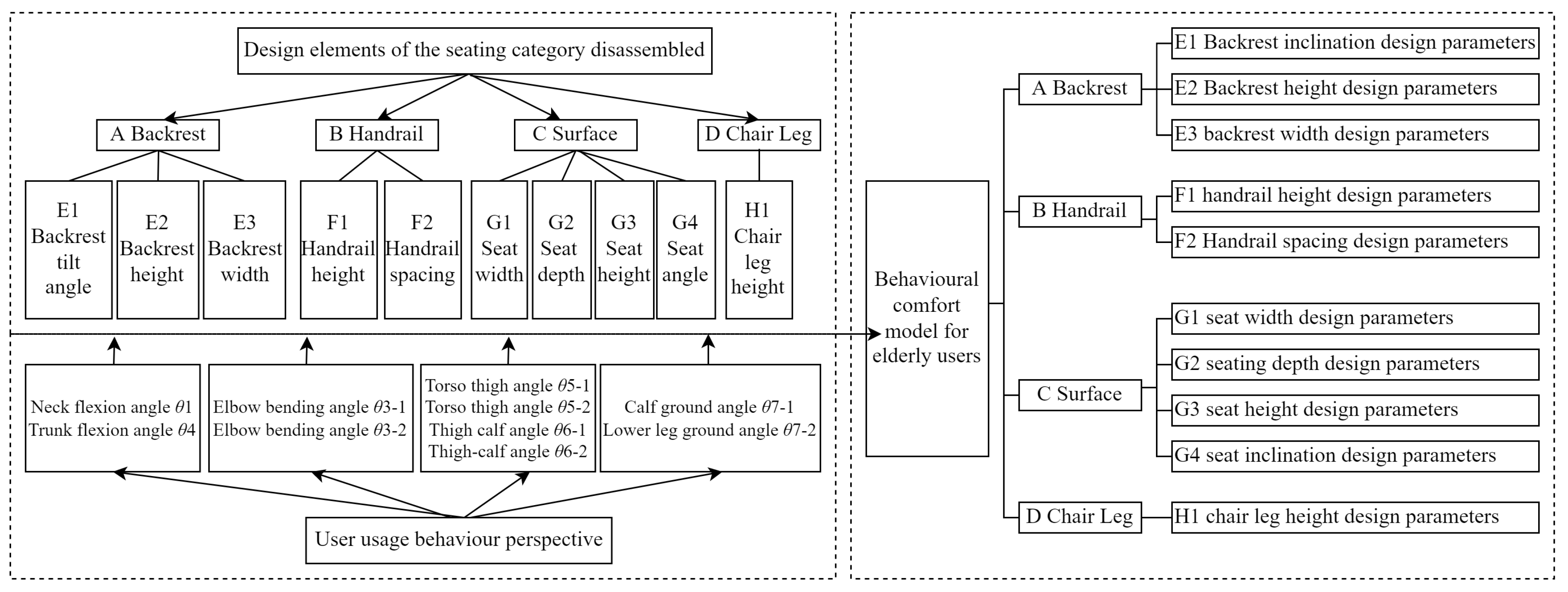



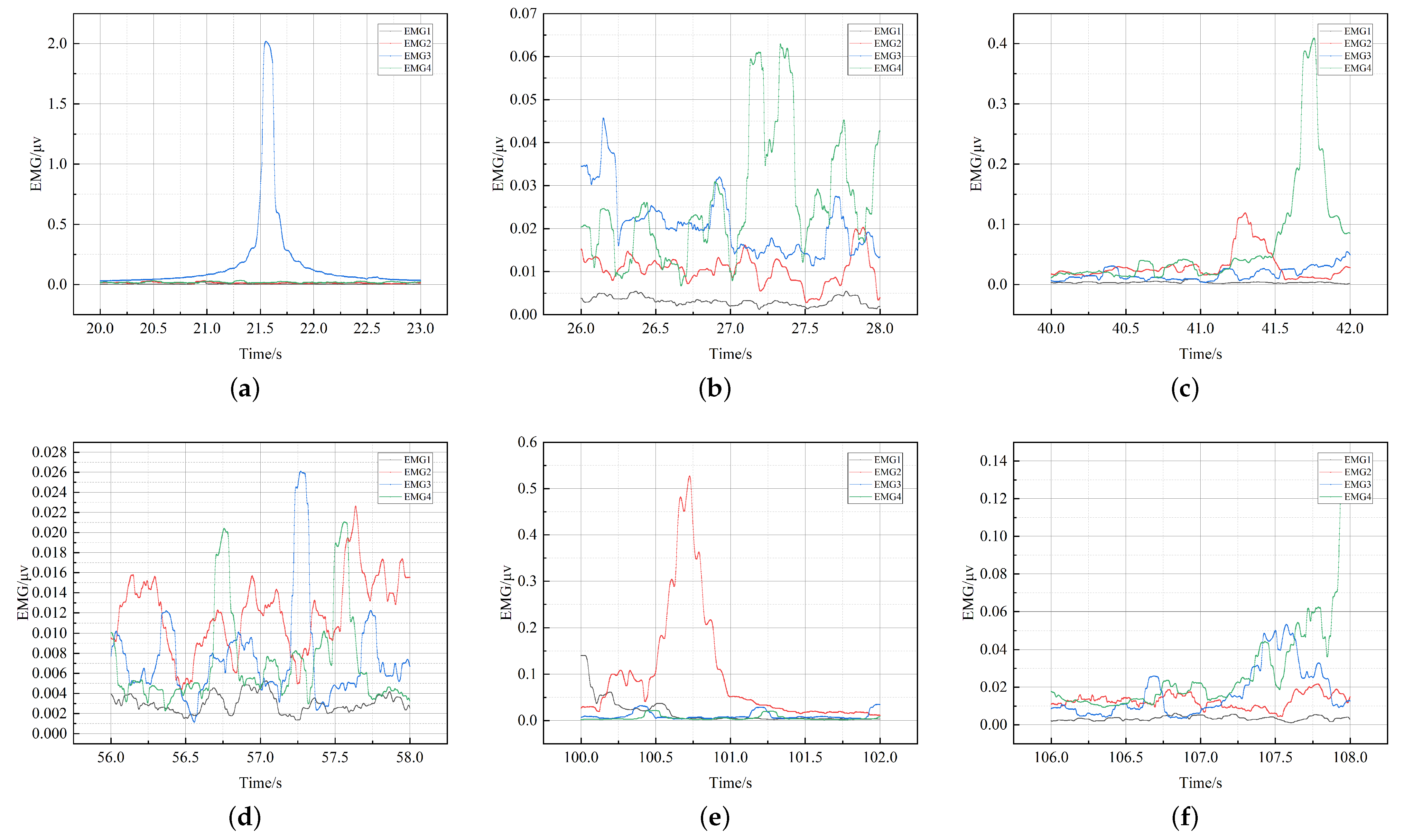
| Items | Feature Vectors | Weighting Values | Maximum Eigenvalues | CI Values |
|---|---|---|---|---|
| B1 function | 1.908 | 47.700% | ||
| B2 shape | 0.609 | 15.223% | 4.067 | 0.022 |
| B3 colour | 0.329 | 8.232% | ||
| B4 material | 1.154 | 28.845% |
| Items | Values | ||||||
|---|---|---|---|---|---|---|---|
| nth order | 3 | 4 | 5 | 6 | 7 | 8 | 9 |
| RI values | 0.52 | 0.89 | 1.12 | 1.26 | 1.36 | 1.41 | 1.46 |
| nth order | 10 | 11 | 12 | 13 | 14 | 15 | 16 |
| RI values | 1.49 | 1.52 | 1.54 | 1.56 | 1.58 | 1.59 | 1.5943 |
| nth order | 17 | 18 | 19 | 20 | 21 | 22 | 23 |
| RI values | 1.6064 | 1.6133 | 1.6207 | 1.6292 | 1.6383 | 1.6403 | 1.6462 |
| nth order | 24 | 25 | 26 | 27 | 28 | 29 | 30 |
| RI values | 1.6497 | 1.6556 | 1.6587 | 1.6631 | 1.6670 | 1.6693 | 1.6724 |
| Angle Categories | Geriatric Group Threshold | Control Group Threshold | Importance Index | Importance of Normalization |
|---|---|---|---|---|
| Neck Bending Angle 1 | , | , | ||
| Torso Arm Angle 2-1 | , | , | ||
| Torso Arm Angle 2-2 | , | , | ||
| Elbow Bending Angle 3-1 | , | , | ||
| Elbow Bending Angle 3-2 | , | , | ||
| Torso Bending Angle 4 | , | , | % | |
| Torso Thigh Angle 5-1 | , | , | ||
| Torso Thigh Angle 5-2 | , | , | ||
| Thigh Calf Angle 6-1 | , | , | ||
| Thigh Calf Angle 6-2 | , | , | ||
| Calf-ground Angle 7-1 | , | , | ||
| Calf-ground Angle 7-2 | , | , |
| Code | Elements | Mapped Body Values | Mapping Joint Angles | Comfort Rating |
|---|---|---|---|---|
| E1 Backrest Inclination | Sitting Shoulder Height | Neck Flexion Angle 1 | 1–5 out of 5 | |
| A | E2 Backrest Height | Seated Shoulder Height | Trunk Flexion Angle 4 | 1–5 out of 5 |
| E3 Backrest Width | Shoulder Width | 1–5 out of 5 | ||
| F1 Armrest Height | Sitting Elbow Height | 1–5 Points | ||
| B | F2 Armrest Spacing | Width Between Elbows | Elbow Flexion Angle 3-1 | 1–5 Points |
| in Sitting Position | ||||
| C | G1 Seat Width | Sitting Hip Width | Elbow Flexion Angle 3-2 | 1–5 Marks |
| G2 Seat Depth | Sitting Depth | 1–5 Marks | ||
| G3 Seat Height | Calf Plus Foot Height | Torso Thigh Angle 5-1 | 1–5 Marks | |
| G4 Seat Inclination | Calf Plus Foot Height | Torso Thigh Angle 5-2 | 1–5 Marks | |
| D | H1 Height of Chair Legs | Calf Plus Foot Height | Thigh Calf Angle 6-1 | 1–5 Marks |
| Comparison | This Work | [31] | [32] | [33] | [34] | [35] |
|---|---|---|---|---|---|---|
| Study Subjects | Elderly | Youth | General | Youth | Customized | Office |
| Research Methods | Behavior, Two-Dimensional Measurements | CMSDs Ergonomic, Subjective | Likert Scale Questionnaire, Field Research | Sample Research, Actual, Classified Counting | Skeleton Capture, Pressure Distribution, Intelligent Algorithm | Market Research, Model Construction Measurement |
| Research Tools | Kinect | Measuring tools | Visit to Ask | Research | Virtual modeling | Mismatch Equations |
| Application | Age-Friendly | Student Desks | Eco-Friendly | Teaching | Customized | Office |
| Scenarios | Smart Sofa | and Chairs | Furniture | Furniture | Furniture | Furniture |
| Design Verification | EMG | Use Test | Cost Measurement | Use Test | Design Experience | Interview Feedback |
Publisher’s Note: MDPI stays neutral with regard to jurisdictional claims in published maps and institutional affiliations. |
© 2022 by the authors. Licensee MDPI, Basel, Switzerland. This article is an open access article distributed under the terms and conditions of the Creative Commons Attribution (CC BY) license (https://creativecommons.org/licenses/by/4.0/).
Share and Cite
Zhou, C.; Huang, T.; Luo, X.; Kaner, J.; Fu, X. Recognition and Analysis of an Age-Friendly Intelligent Sofa Design Based on Skeletal Key-Points. Int. J. Environ. Res. Public Health 2022, 19, 11522. https://doi.org/10.3390/ijerph191811522
Zhou C, Huang T, Luo X, Kaner J, Fu X. Recognition and Analysis of an Age-Friendly Intelligent Sofa Design Based on Skeletal Key-Points. International Journal of Environmental Research and Public Health. 2022; 19(18):11522. https://doi.org/10.3390/ijerph191811522
Chicago/Turabian StyleZhou, Chengmin, Ting Huang, Xin Luo, Jake Kaner, and Xiaoman Fu. 2022. "Recognition and Analysis of an Age-Friendly Intelligent Sofa Design Based on Skeletal Key-Points" International Journal of Environmental Research and Public Health 19, no. 18: 11522. https://doi.org/10.3390/ijerph191811522
APA StyleZhou, C., Huang, T., Luo, X., Kaner, J., & Fu, X. (2022). Recognition and Analysis of an Age-Friendly Intelligent Sofa Design Based on Skeletal Key-Points. International Journal of Environmental Research and Public Health, 19(18), 11522. https://doi.org/10.3390/ijerph191811522






